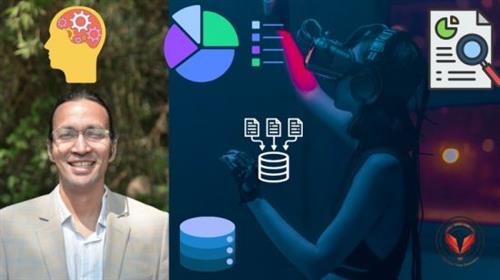- Thread Starter
- #1

Application of Data Science for Data Scientists | AIML TM
Published 9/2024
MP4 | Video: h264, 1280x720 | Audio: AAC, 44.1 KHz, 2 Ch
Language: English | Duration: 8h 32m | Size: 4.06 GB
What you'll learn
Students will learn the fundamentals of Data Science and its applications across various industries.
Students will explore key algorithms and perform exploratory data analysis (EDA).
Students will learn about the roles, skills, and responsibilities of a Data Scientist.
Students will dive into advanced techniques and practical applications used by Data Scientists.
Students will learn the stages of the Data Science process, from problem definition to data collection.
Students will explore model building, evaluation, deployment, and post-deployment strategies.
Students will apply Data Science concepts to solve a real-world case study from start to finish.
Students will learn how to ensure data quality and make their models interpretable.
Students will explore the ethical considerations and responsibilities involved in Data Science.
Students will examine the ethical dilemmas surrounding data collection, privacy, and bias.
Students will understand how to manage and execute a Data Science project from planning to reporting.
Students will learn techniques for selecting and engineering relevant features to improve model performance.
Students will explore how to implement and scale Data Science solutions in real-world applications.
Students will master data wrangling and manipulation techniques to efficiently handle large datasets.
Requirements
Anyone can learn this class it is very simple.
Description
1. Introduction to Data ScienceOverview of what Data Science isImportance and applications in various industriesKey components: Data, Algorithms, and InterpretationTools and software commonly used in Data Science (e.g., Python, R)2. Data Science Session Part 2Deeper dive into fundamental conceptsKey algorithms and how they workExploratory Data Analysis (EDA) techniquesPractical exercises: Building first simple models3. Data Science Vs Traditional AnalysisDifferences between traditional statistical analysis and modern Data ScienceAdvantages of using Data Science approachesPractical examples comparing both approaches4. Data Scientist Part 1Role of a Data Scientist: Core skills and responsibilitiesKey techniques a Data Scientist uses (e.g., machine learning, data mining)Introduction to model building and validation5. Data Scientist Part 2Advanced techniques for Data ScientistsWorking with Big Data and cloud computingBuilding predictive models with real-world datasets6. Data Science Process OverviewSteps of the Data Science process: Problem definition, data collection, preprocessingBest practices in the initial phases of a Data Science projectExamples from industry: Setting up successful projects7. Data Science Process Overview Part 2Model building, evaluation, and interpretationDeployment of Data Science models into productionPost-deployment monitoring and iteration8. Data Science in Practice - Case StudyHands-on case study demonstrating the Data Science processProblem-solving with real-world dataStep-by-step guidance from data collection to model interpretation9. Data Science in Practice - Case Study: Data Quality & Model InterpretabilityImportance of data quality and handling missing dataTechniques for ensuring model interpretability (e.g., LIME, SHAP)How to address biases in your model10. Introduction to Data Science EthicsImportance of ethics in Data ScienceHistorical examples of unethical Data Science practicesGuidelines and frameworks for ethical decision-making in Data Science11. Ethical Challenges in Data Collection and CurationChallenges in ensuring ethical data collection (privacy concerns, data ownership)Impact of biased or incomplete dataHow to approach ethical dilemmas in practice12. Data Science Project LifecycleOverview of a complete Data Science project lifecycleManaging each phase: Planning, execution, and reportingTeam collaboration and version control best practices13. Feature Engineering and SelectionTechniques for selecting the most relevant featuresDimensionality reduction techniques (e.g., PCA)Practical examples of feature selection and its impact on model performance14. Application - Working with Data ScienceHow to implement Data Science solutions in real-world applicationsCase studies of successful applications (e.g., fraud detection, recommendation systems)Discussion on the scalability and robustness of models15. Application - Working with Data Science: Data ManipulationTechniques for data wrangling and manipulationWorking with large datasets efficientlyUsing libraries like Pandas, NumPy, and Dask for data manipulationThis framework covers key aspects and ensures a deep understanding of Data Science principles with practical applications.
Who this course is for
Anyone who wants to learn future skills and become Data Scientist, Ai Scientist, Ai Engineer, Ai Researcher & Ai Expert.
Homepage:
Screenshots

Download link
rapidgator.net:
You must reply in thread to view hidden text.
ddownload.com:
You must reply in thread to view hidden text.
